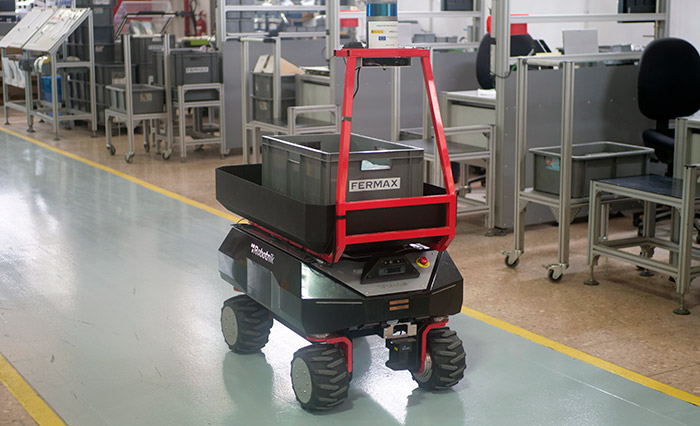In the search for improved efficiency and safety in warehouse management, advanced technology is a crucial catalyst. Specifically, autonomous mobile robots (AMR) demonstrate to be an invaluable tool in optimizing operations. This article explores the contributions and benefits of integrating AMR into warehouses, focusing on security and logistics management aspects.
WAREHOUSE SAFETY: A PRIORITY FOR THE INDUSTRY
Warehouse safety is a fundamental concern in every logistics environment. The introduction of autonomous mobile robots has radically transformed this landscape, offering innovative solutions to mitigate risks and improve working conditions. Here are some examples of Robotnik’s mobile robots in warehouses and how they provide improvements in warehouse safety.
Secure collaboration with humans:
AMR are designed with advanced navigation, sensors, and safety laser systems, significantly reducing collisions and accidents in the warehouse. Sensors, cameras, and machine learning algorithms allow robots to anticipate obstacles and adjust their routes in real time, ensuring a safer working environment, including environments shared with operators.
Incorporating Robotnik’s AMR as part of the warehouse management process does not mean the exclusion of human labor. These collaborative robots are designed to collaborate securely with employees. In this way, they contribute to improving safety in the warehouse in two ways: by enabling human-robot cooperation and by performing dangerous tasks, which were previously handled by people.
Reduction of accidents and injuries:
Automating routine and dangerous tasks decreases the likelihood of workplace accidents and risks. In automated logistics processes, AMR take on duties such as transporting heavy loads and repetitive motions, freeing up employees to focus on tasks that require higher-value skills.
AUTOMATED LOGISTICS: OPTIMIZING PROCESSES
Efficiency is key to warehouse management. In the face of global and highly competitive global players, automated logistics is paramount to meet the demands of today’s market. The integration of autonomous mobile robots offers a number of advantages for optimizing workflow and logistics management.
Route and time optimization: AMR improves the times in which certain routine tasks such as the transport of parts or supply in the production chain are carried out, calculating and optimizing the most efficient routes.
Real-time inventory: Inventory management is a critical and labor-intensive task in any warehouse. Mobile robots can integrate scanning and tracking technology that allows for real-time inventory keeping. This minimizes errors and losses, providing greater precision in stock control.
Adaptability to demand: With the ability to dynamically adjust to market demands, AMRs allow for greater flexibility in warehouse management. This adaptability translates into the ability to scale operations as needed, without compromising efficiency.
AUTONOMOUS MOBILE ROBOTICS FOR WAREHOUSE MANAGEMENT: INCREASING PRODUCTIVITY
In short, the integration of autonomous mobile robots in warehouses and factories represents a unique synergy between safety and logistics profitability. Bringing improvements ranging from reducing accidents to improving inventory management, AMR are already a reality in smarter and more sustainable logistics environments.
Robotnik has developed several mobile robots to optimize and automate tasks in logistics environments. Do you want to know which robots fit the needs of your application? Here you can find them classified.
If you need to ask any particulars, write to the form and our team will answer you.
FAQs about robotics
AMRs keep a real-time record of inventory using scan-and-track technology, minimizing errors and improving stock accuracy.
Mobile robots are capable of optimizing routes, reducing cycle times and providing real-time inventory, improving process efficiency.
Robotnik has classified its portfolio of autonomous mobile robots and manipulators according to the industries in which they can operate and the tasks that add value to each of them.



